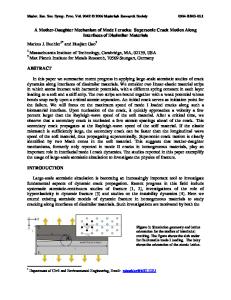In-Situ Observations on Crack Propagation Along Polymer/Glass Interfaces.
- PDF / 4,028,265 Bytes
- 6 Pages / 595 x 842 pts (A4) Page_size
- 89 Downloads / 350 Views
O10.3.1
In-situ observations on crack propagation along polymer/glass interfaces. W.P.Vellinga, R.Timmerman, R.van Tijum, J.Th.M. De Hosson Materials Science Centre, University of Groningen Nijenborgh 4, 9747 AG, Groningen, the Netherlands ABSTRACT The propagation of crack fronts along a PET-glass interface is illustrated. The experimental set-up consists of an Asymmetric Double Cantilever Beam in an optical microscope. Image processing techniques used to isolate the crack fronts are discussed in some detail. The fronts are found to propagate inhomogeneously in space and time, in forward bursts that spread laterally along the front for some distance. In some cases the forward movement of a crack can be almost entirely due to the lateral movement of forward steps (analogous to “kinks”) along the crack front. INTRODUCTION Interest in the mechanical properties of polymer-metal laminates is rising since they appear in an ever increasing number of applications, as diverse as car panels and high-tech displays. Of course the mechanical integrity of the interfaces in such applications is important. As the failure of such an interface usually implies the propagation of a crack along it, this is a clear target for investigation. In the field of crack propagation there is growing interest in bringing together theory used in continuum mechanics with ideas from statistical physics. This seems especially helpful in the area of lifetime prediction where quantities accessible from continuum mechanics (stresses, stress intensity factors, energy release rates) may be related to the interplay between disorder and stress aided thermally activated processes [1]. Crack propagation in itself is of interest as recently intriguing results on crack front instabilities and scaling behavior have been encountered in experiment and theory [2,3]. It has been observed in experiment that the response of stressed disordered media may show bursts of widely distributed magnitude, pointing to an internal avalanche dynamics. The work presented here is related to the works mentioned above but is original in a number of aspects, ranging from the system studied to the data treatment involved and the actual dynamics observed. We present observations on the propagation of cracks along polymer-glass and polymer-metal interfaces. EXPERIMENT The experimental method is an Asymmetric Double Cantilever Beam test. The actual set-up is based on a miniature tensile stage (Kammrath&Weiss) which fits in a reflection optical microscope. Driving speeds for the cracks are typically 10 µm/s. Samples consist of Poly-Ethylene Terephthalate (PETG) spin-coated on steel, thickness, dried in a convection oven at 80°C for a few hours, and subsequently pressure bonded to a glass support (for 240s, at 140°C and 1.5 MPa). For a schematic picture of the experiment see figure 1. The crack front is observed through the glass with a CCD camera (1376*1032 pixels, 3*8 bit) at a rate of 1 Hz
O10.3.2
ADCB Excellent papers dealing with Asymmetric Double Cantilever Beam (ADCB) experiments
Data Loading...











